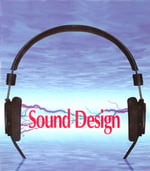 By David Sonnenschein, author Sound Design: The Expressive Power of Music, Voice and Sound Effects in Cinema.
By David Sonnenschein, author Sound Design: The Expressive Power of Music, Voice and Sound Effects in Cinema.
Key 3: Description of the environment gives clues for the sounds
Information about the environment first appears in the scene headings, which are as succinct as possible to help the production manager do the breakdown and which denote three items: EXTERIOR or INTERIOR, LOCATION (with perhaps HISTORICAL PERIOD) and TIME OF DAY. Then there usually is a modest amount of detail given in the first paragraph of scene description, appearing something like this:
EXT. CORNFIELD - NIGHTThe rows of corn stalks bathe motionlessly in the moonlight. In the middle of the field, a single stalk begins to shake, slowly at first, then possessed with a nervous energy that spreads contagiously to its neighbors.
Part of your job will be to create the reality of these explicit locations and times, but for now you should look for the subtext that these environments may lend to the development of the story and characters. The above scene could belong to a terror or comedy film, and may mix the genres to have an even greater impact at the moment of tension and turning point in the narrative. Let’s assume this is a pure terror film, introducing since the beginning of the script (with an appropriate title) a supernatural, malevolent force.
The words “Night”, “motionlessly” and “moonlight” tell us this would be a quiet place, but what might be the type of silence that would contrast well with the first break of that silence by the rustling of the cornstalk? To best hear the cornstalk’s shaking, which will be a random mixture of fairly high frequencies, the contrasting background “silence” could be a single frog croaking in a lower register with a defined periodicity. Attention will be heightened when the sounds of “silence” non-competitively fill in the tonal and rhythmic spectrums, with our brains more readily registering the aural contrast.
 The distance or intimacy of the sounds can transmit a dramatic intent by telling us where we are and what might be a threatening noise to be noticed. We can decrease the frog’s immediacy by filtering out the higher frequencies in its croak and giving a tiny reverb to lend a sense of calmness, distance and surrounding space. By accenting the high frequencies of the cornstalk shaking we create a greater presence. If we choose to make the environment subjectively and claustrophobically collapse, the frog croak can gain on the high frequencies, while multiplying the croaks to have frogs surround us from all sides. Or we can do the opposite with the cornstalks as their movement spreads menacingly, by adding reverb and increasing the volume to the point of filling up the whole environment, and our subjective head space as well.
The distance or intimacy of the sounds can transmit a dramatic intent by telling us where we are and what might be a threatening noise to be noticed. We can decrease the frog’s immediacy by filtering out the higher frequencies in its croak and giving a tiny reverb to lend a sense of calmness, distance and surrounding space. By accenting the high frequencies of the cornstalk shaking we create a greater presence. If we choose to make the environment subjectively and claustrophobically collapse, the frog croak can gain on the high frequencies, while multiplying the croaks to have frogs surround us from all sides. Or we can do the opposite with the cornstalks as their movement spreads menacingly, by adding reverb and increasing the volume to the point of filling up the whole environment, and our subjective head space as well.
Stay tuned for Key 4 next month, and visit www.SoundDesignForPros.com to sign up for info on sound design webinars with David Sonnenschein.












